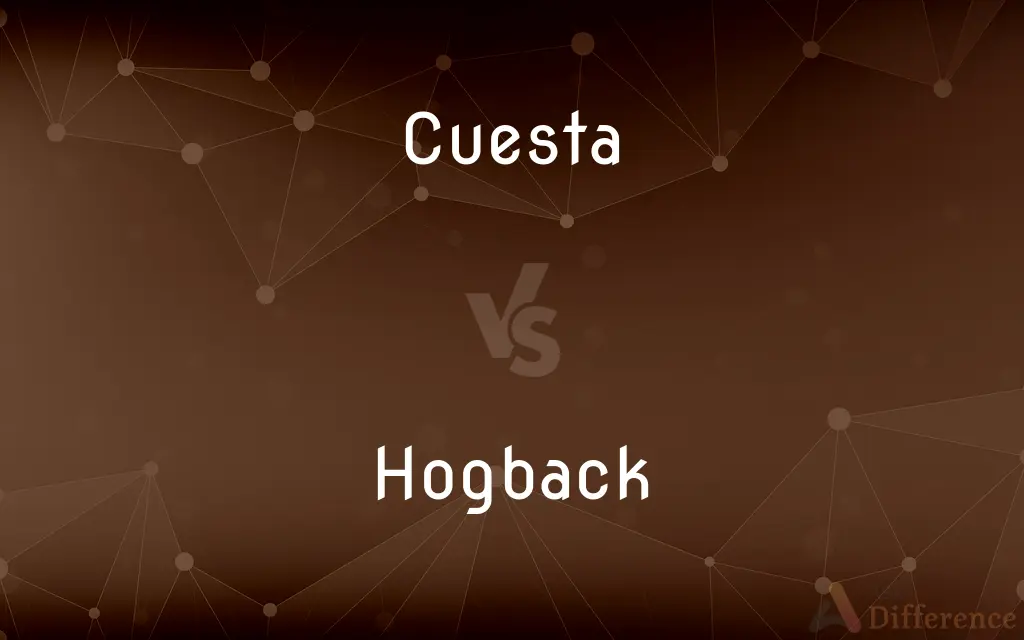Cuesta vs. Hogback — What's the Difference?
By Tayyaba Rehman & Urooj Arif — Updated on March 18, 2024
Cuestas feature a gentle slope on one side and a steep scarp on the other, while hogbacks are narrow ridges with steep slopes on both sides.

Difference Between Cuesta and Hogback
Table of Contents
ADVERTISEMENT
Key Differences
Cuestas are geological formations characterized by a gentle dip slope that contrasts with a steeper scarp slope on the opposite side. This asymmetry is due to differential erosion of tilted sedimentary layers. Hogbacks, on the other hand, are more symmetrical, featuring narrow ridges with steep slopes on both sides, formed by the erosion of hard, resistant strata that are often tilted.
The formation of a cuesta involves the erosion of softer sedimentary rock layers, leaving behind a slope that gently dips away from the resistant caprock. This results in a landscape where one side of the cuesta slopes gradually, whereas the other side presents a sharp decline. In contrast, hogbacks form when harder rock layers are exposed and eroded on both sides, leading to a ridge-like feature with steep slopes on both sides, often resembling the backbone of a hog.
Cuestas are typically wider and have a more extensive gentle slope, making them less pronounced than hogbacks. This can influence the type of vegetation and ecosystems that develop on their surfaces. Hogbacks, due to their steep and narrow nature, may have limited vegetation and are more prone to erosion, which affects the surrounding ecosystem differently.
The orientation of cuestas and hogbacks relative to their surrounding landscape can influence water runoff, soil deposition, and local microclimates. Cuestas may have a significant impact on local hydrology due to their asymmetrical slopes, while hogbacks, with their steep sides, may lead to quicker runoff and less soil retention.
Despite their differences, both cuestas and hogbacks contribute to the diversity of a region's topography, offering unique habitats and influencing weather patterns. They are important features in understanding the geological history and evolution of an area.
ADVERTISEMENT
Comparison Chart
Slope
One gentle, one steep
Steep on both sides
Formation
Differential erosion of sedimentary layers
Erosion of hard, resistant strata
Shape
Asymmetrical, wider
Symmetrical, narrow
Ecosystem Impact
Supports varied vegetation due to gentle slope
Limited vegetation due to steep slopes
Hydrology
Influences water runoff and soil deposition
Leads to quick runoff, less soil retention
Compare with Definitions
Cuesta
A landform with one gentle slope and one steep scarp, resulting from erosion.
The cuesta's gentle slope was covered in lush greenery.
Hogback
A narrow ridge with steep slopes on both sides, resembling a hog's back.
The hogback rose sharply from the surrounding plains.
Cuesta
Formed by the differential erosion of sedimentary rock layers.
Geologists studied the cuesta to understand its sedimentary layers.
Hogback
Results from the erosion of hard, resistant strata.
The hogback's resilience was due to its hard rock composition.
Cuesta
Supports a variety of ecosystems due to its gradual incline.
The cuesta's slope was home to a diverse range of plant species.
Hogback
Features a more symmetrical shape compared to cuestas.
The hogback's symmetry made it a striking feature in the landscape.
Cuesta
Influences local water runoff and soil deposition patterns.
The cuesta's formation affected the area's hydrology significantly.
Hogback
Often has limited vegetation due to its steepness.
Sparse vegetation clung to the steep sides of the hogback.
Cuesta
Characterized by its asymmetrical profile, blending into the landscape.
From a distance, the cuesta melded seamlessly with the surrounding terrain.
Hogback
Leads to quicker water runoff, impacting soil retention.
Rainwater swiftly flowed down the hogback's slopes, carrying soil with it.
Cuesta
A cuesta (from Spanish cuesta "slope") is a hill or ridge with a gentle slope on one side, and a steep slope on the other. In geology the term is more specifically applied to a ridge where a harder sedimentary rock overlies a softer layer, the whole being tilted somewhat from the horizontal.
Hogback
A sharp ridge with steeply sloping sides, produced by erosion of the broken edges of highly tilted strata.
Cuesta
A ridge with a gentle slope on one side and a cliff on the other.
Hogback
(geology) A sharp steep-sided ridge formed by the erosion of tilting strata
Cuesta
(geomorphology) A hill or ridge with a gentle slope on one side, and a steep slope on the other.
Hogback
A hogframe.
Cuesta
A sloping plain, esp. one with the upper end at the crest of a cliff; a hill or ridge with one face steep and the opposite face gently sloping.
Hogback
A Viking grave marker taking the form of a recumbent monument, generally with a curved (hogbacked) ridge and outwardly curved sides.
Hogback
An upward curve or very obtuse angle in the upper surface of any member, as of a timber laid horizontally; - the opposite of camber.
Hogback
See Hogframe.
Hogback
A ridge formed by tilted strata; hence, any ridge with a sharp summit, and steeply sloping sides.
Hogback
A narrow ridge of hills
Common Curiosities
Which is more common, cuestas or hogbacks?
It depends on the geological conditions of the area; both can be common in areas with suitable rock formations.
What defines a cuesta?
A cuesta is a ridge with a gentle slope on one side and a steep scarp on the other, formed by the differential erosion of sedimentary layers.
Can cuestas and hogbacks be found together?
Yes, they can be part of the same geological region, representing different stages or conditions of erosion.
Are hogbacks always narrow and sharp?
Generally, yes, hogbacks are characterized by their narrow and sharp ridge-like appearance.
Do cuestas have a specific orientation?
Yes, the gentle slope typically faces the direction of the dipping rock layers, while the steep scarp faces the opposite.
How do cuestas and hogbacks affect biodiversity?
Cuestas can support diverse ecosystems on their gentle slopes, while hogbacks may have more limited biodiversity due to their steepness.
Can human activities impact the formation of cuestas and hogbacks?
While human activities can influence erosion and vegetation, the fundamental formation of cuestas and hogbacks is primarily a natural geological process.
Are there famous examples of cuestas or hogbacks?
Yes, many regions around the world have notable examples, often highlighted in geological tours or studies.
How is a hogback formed?
A hogback is formed through the erosion of hard, resistant strata, resulting in a narrow ridge with steep slopes on both sides.
What is the main difference between a cuesta and a hogback?
The main difference lies in their slopes: cuestas have one gentle slope, while hogbacks have steep slopes on both sides.
What role do hogbacks play in a region's topography?
Hogbacks contribute to the ruggedness and variety of a landscape, often forming natural barriers or drainage divides.
How do cuestas influence local water systems?
The asymmetrical slopes of cuestas can affect water runoff, leading to different patterns of soil deposition and water flow.
Can the erosion of a hogback lead to the formation of a cuesta?
Over time, erosion could potentially transform a hogback into a cuesta if one side erodes more gently, but this would depend on many factors.
What geological processes contribute to the erosion of cuestas and hogbacks?
Processes like water runoff, wind erosion, and the freeze-thaw cycle can all contribute to the erosion and shaping of these landforms.
How can one identify a cuesta in the landscape?
Look for a ridge with a noticeable difference in slope steepness on its sides; the gentler slope indicates a cuesta.
Share Your Discovery

Previous Comparison
Knuckleball vs. Curveball
Next Comparison
Deliberate vs. IntentionalAuthor Spotlight
Written by
Tayyaba RehmanTayyaba Rehman is a distinguished writer, currently serving as a primary contributor to askdifference.com. As a researcher in semantics and etymology, Tayyaba's passion for the complexity of languages and their distinctions has found a perfect home on the platform. Tayyaba delves into the intricacies of language, distinguishing between commonly confused words and phrases, thereby providing clarity for readers worldwide.
Co-written by
Urooj ArifUrooj is a skilled content writer at Ask Difference, known for her exceptional ability to simplify complex topics into engaging and informative content. With a passion for research and a flair for clear, concise writing, she consistently delivers articles that resonate with our diverse audience.
















































